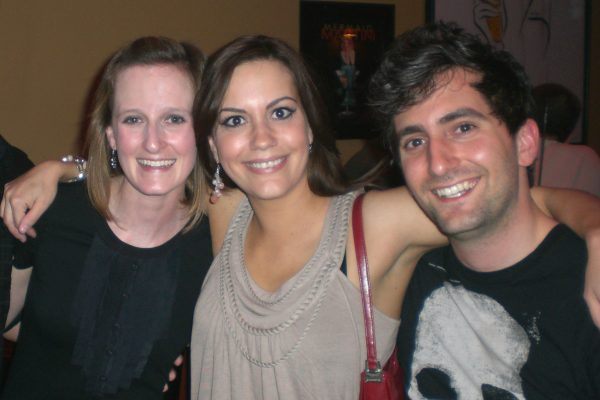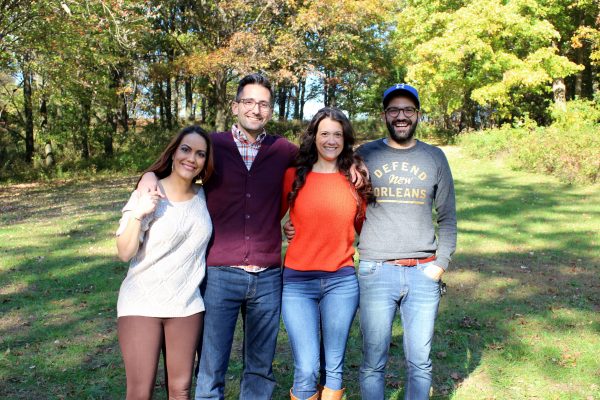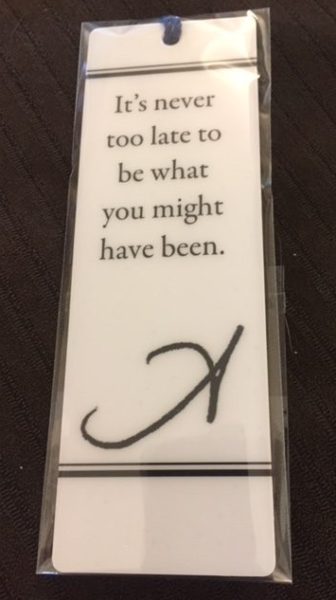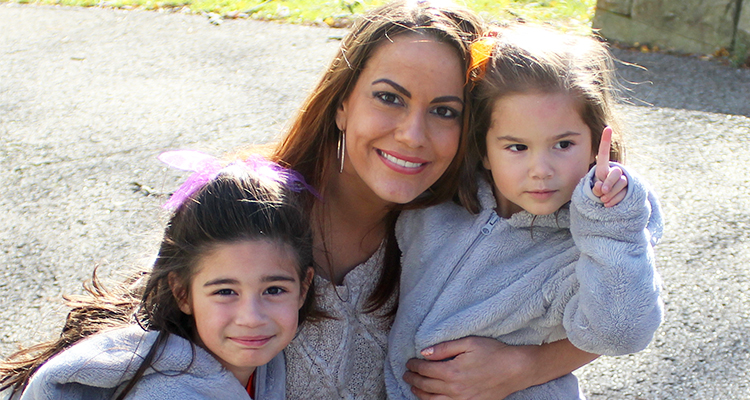There’s a line in the song “Wait for It” from the musical “Hamilton” — “Love doesn’t discriminate between the sinners and the saints. It takes and it takes and it takes.” The same can be said for addiction.
_____________________________________________________
1. Quirky. Bold. Loud. Honest. Upbeat. Determined. Business-savvy. Together. Fun. Stubborn. Gorgeous. Talented. Mother. Breath of fresh air.
2. Drug addict.
Could these two paragraphs possibly be describing the same person?
Yes. Angela Phillips was all of those things. The quirky, loving, talented, beautiful, together mom died of a drug overdose on Dec. 7, 2016, at the age of 34.
Angela’s sister-in-law Amy Phillips wants the world to know that it can happen to anyone. Anyone.
Angela’s brother Mark Phillips wants the world to know that it shouldn’t.
“When [people] look at her picture, they say, oh my gosh she’s so beautiful, she doesn’t look like someone who’d have an addiction. But people with addiction don’t look all the same. They don’t. That’s a stereotype that people have,” Amy said.
Mark believes enough isn’t being done to help drug addicts and their families. That the right conversations aren’t happening to prevent more drug overdoses. That the current model of treatment is not an effective one.

IT’S HAPPENING TO ALL OF US
Drug addiction is everyone’s problem. “It’s happening to us. … It’s happening in populations that it wasn’t previously happening in — people with fairly normal upbringing. ”
Both Mark and Amy work at Wheeling Jesuit Univerity. He is chief of staff; she’s a literature professor. They live in Woodsdale with their 6-year-old Ben, who will never know his Aunt Angela.
A drug overdose in Mark’s family was not something anyone ever anticipated. “There was not a conversation about drugs or alcohol abuse in our family. It was not something we’d think about, and that’s dangerous. I think people should recognize that people you love could end up in a situation like this,” he said.
“Because the problem is stigmatized, nobody really talks about it. … People don’t say to one another, ‘How did you get there and how can we help?’”
Even in the five-minute version of himself, Mark wants people to know that his family has suffered from addiction. “That’s a heavy thing to lay on a light cocktail conversation,” he said, but he wants to be honest and talk about Angela.
“My family looks pretty tight. It’s unexpected when I say that happened in my family, and I want people to know that it’s not a rare thing, that it should not be a surprise for you, based on the numbers that you see — especially in this part of the country. Go ask five people if someone close to them has passed away from an opioid addiction or suffered with that addiction, and you’re going to get one of them for sure, probably a couple. And, until we recognize that and start dealing with that as a problem that we need to start thinking about together to solve, it’s not going to get any better,” he said.
“When I talk to my mom,” — who is now raising Angela’s two daughters, Mia, 8, and Anna, 6 — “we talk about what could we have done differently,” Mark said. “That’s the only regret we have. You want to help, but we never had a conversation that was, ‘Oh my God, I’m so sorry you’re in a place where you’re trapped by this. How can we help you? What do you need? We love and support you. We’ll help you get to the next step.’”

ANGELA’S STORY
The last time Amy saw Angela was in October two years ago, just weeks before she died. Angela was sober. She was planning to talk to Amy’s classes at WJU about drug addiction.
“She wanted to tell her story. She didn’t want anyone to go through what she had gone through,” Amy said.
She was going to explain how she got involved with drugs. How she was diagnosed with autoimmune diseases and began taking prescription pills to help with the pain. How she began to abuse those pills.
Eventually, there were signs, Amy recalled. Angela would doze off when sitting up. She’d slur her words. She’d forget things. She’d have mood swings. She was disorganized. The “together” person didn’t have it together. “Cracks in the veneer,” as Amy put it.
It was Angela’s older daughter who accidentally incriminated her: “Mommy takes naps. Mommy doesn’t put breakfast on the table. …”
But, “never in our wildest dreams did [addiction] cross our minds.”
In March of 2016, Angela “reluctantly” checked into rehab, but didn’t take it seriously, Amy said.
While in rehab she met a man; he introduced her to heroin when they both got out. That was the “beginning of the end,” Amy said.
“She did a 180. She filed for divorce; she got evicted from her home; her car got impounded; there was a warrant out for her arrest, she was prostituting herself for drug money, working at a strip club, and she relinquished custody of her children.”
That was not the Angela that Mark and Amy knew.
“She did a 180. She filed for divorce; she got evicted from her home; her car got impounded; there was a warrant out for her arrest, she was prostituting herself for drug money, working at a strip club, and she relinquished custody of her children.” That was not the Angela that Mark and Amy knew.
However, Amy explained, she did check herself into rehab a second time — in August of 2016 — this time for heroin abuse. She was doing well. “Like the old Angela. She was happy. She was healthy.”
Angela moved in with her brother Paul and was holding down a job at his wife’s flower shop.
“We were really proud of her.”
In fact, on Nov. 29, 2016, she celebrated 90 days of sobriety.
A week later, she overdosed on heroin laced with fentanyl. She was found dead in a hotel room, after those she was getting high with called the front desk from a pay phone across the street to suggest “checking on the girl” in room whatever before high-tailing it out of there.
Amy’s tears come — not the first time during the interview.
“And they left her there. Just left. And that’s one of the things I always think … addiction doesn’t discriminate. Because then she wasn’t somebody’s mother, or sister or daughter … she was an addict that was going to get them arrested. I thank them in my heart that they called someone. … She was dead when they found her. … Coroner’s report came back that it was heroin laced with fentanyl. Most likely she did not know what she was sold. And that’s what killed her.
“For her, it was not a long journey, it was such a small part of her life.”
But, she had a disease, Amy said. “It wasn’t a choice. It was a disease. … I loved her like a sister. … It’s been very hard. It’s hard to watch my son. He’ll never know her. It’s hard to think that he will grow up and what she will be to him is a lesson of what not to do, and she deserves more than that, and that’s hard.”
 WHAT CAN BE DONE?
WHAT CAN BE DONE?
The first step, Mark believes, is there has to be a grassroots effort among those who have been affected by addiction. “To continue to have an open dialogue about this, to have voices for the people who are suffering with this. To continually remind people that those are people who are dealing with a serious issue that they can’t help, but we can. … It can get better, and we understand there are resources that can help. There are people we can talk to. How do we get those resources into the hands of people who can help the most? …
“There can be much better training at hospitals throughout the state. There can be much better training at middle schools and high schools. … There are lots of public universities that can be engaged in this process. There are YMCAs that may be tangential to this issue, but there are places that people are going in the early stages of needing help, and if you can get some of these resources to these people then you might do better than what we’re doing right now.”
Both Mark and Amy liken addiction to AIDS in the early 1980s.
“The important part in this conversation is to try to humanize this problem. … And I see it as … a little similar to AIDS in the early ’80s where it’s ‘no, no, that’s not our problem. There’s this population over there, and it’s their problem.’ … Then you realize it’s not a problem over there; just as with HIV and AIDS, these are … friends and sons and daughters and loved ones, and it’s happening to us.”
“I think about [addiction] like … AIDS … that’s what we’re doing with addiction. We make assumptions about who it happens to and what those people are like without understanding that it’s far more complex than that,” Amy said.
Mark noted that Wheeling Jesuit has submitted a grant to the Lilly Foundation “where we would work with the diocese and some faculty members here and train ministers and people in the community to help families and groups to have these kinds of conversations. What tools are out there? What do you really need to do? What do we know works? What can you do as a family member? How you should talk and what should you do — so that then the information is more diffused into the community.”
Mark believes the dialogue is just beginning.
“I think that Catholic Charities does a very good job of connecting people to resources as much as they can. I think that the House of the Carpenter [is] getting increasingly engaged in this issue. Laughlin Chapel, House of Hagar … I think you see those pockets of conversation happening,” he said.
The Community Impact Coalition and Youth Services System recently furthered the dialogue during the Day of Hope event with its interfaith service dedicated to addiction and a rally in downtown Wheeling.
And drug addiction is not like cancer, where you get treatment and it’s gone.
“There’s a lot of shame and helplessness,” and that can cause the problem to reoccur, he pointed out. “The current model of treatment” for addiction is just not effective, Mark said.
PICKING UP THE PIECES
Amy tries to find meaning in the suffering she and Mark and the rest of Angela’s family have experienced, and she wants Angela’s voice to tell the story of addiction.
So, as difficult as it is for her, Amy has spoken to classes at Central Catholic High School, at West Liberty University and at WJU. She teaches “Sonny’s Blues” — a story about a heroin addict and his brother — to her WJU students. “When I teach it, I talk about her. I take her picture and briefly talk about her.
“For me, on behalf of Mark and myself … you have to try to find meaning in the suffering … if there’s a way to help someone else, or do something else or try something else. … I have had people come up after a talk and say ‘that really affected me’ and ‘I think you’re really changing people’s lives.’ I don’t think it’s me — it’s her.
“But if that’s something I can do, then it makes me feel like it wasn’t all for nothing. It’s so painful from day to day. You wake up, and you don’t think about it, then it just hits you. And there are days you are fine. There are days we talk about her and laugh. There are days we can’t get her name out because most of the time I talk about her I cry. There are so many things that are hard about it,” she said.

“Addiction destroys everyone who loves the addict. It’s not just the addict. We will spend the rest of our lives trying to pick up the pieces from losing her,” Amy said.
“We will spend the rest of our lives trying to pick up the pieces from losing her.” — Amy Phillips
ANGELA’S AWARD
In “loving memory” of Angela, Mark and Amy created “Angela’s Award,” presented to a student at Wheeling Jesuit University.
“The award honors research and scholarship activities that explore, engage with or encourage further research on social stigmas, stereotypes or marginalized populations in order to promote a deeper understanding of — rather than simply reinforce — such stigmas,” Amy explained.
The first winner was Jonathon Haley. His project was titled “Adverse Childhood Experiences and Long-Term Health Problems.”
Mark and Amy continue to encourage such research that “has the power to change — and even save — someone’s life.”
“I think she would have approved. I think she would’ve been happy. I just wish we never had to do any of it. I wish she would still be here. But doing things like this somehow makes it feel meaningful, that you’re doing something to honor her.”
SHE WAS ‘MORE THAN HER ADDICTION’
Amy wants people to know that Angela was “so much more than her addiction.”
“She was a beautiful person inside and out; a wonderful mother; a loving sister; a fantastic sister-in-law. … Addicts are people who have stories that deserve to be heard, voices that deserve to be heard. And that we should try to listen to those stories instead of just … lumping them into this category and assuming things about them and just silencing that. … Addiction is a disease.
“That day, when I saw her in October [Angela said], ‘If someone put (heroin) in front of me right now, every bone in my body would want it and I would have to keep saying to myself, no, no, no.’
“And to think about what that’s like to wake up every day … and I don’t think anybody thinks about that, what that’s like, the struggle the addict faces every day to say, ‘I’m going to choose to be clean today. The rest of us are doing that without ever thinking about it, but it’s a struggle, it’s a battle, every day to choose life,” Amy said.
“I believe that Angela is now in a place where she is at peace, no longer in pain, full of love and with her soul whole, completed.”
• After nearly 38 years as reporter, bureau chief, lifestyles editor and managing editor at The Times Leader, and design editor at The Intelligencer and Wheeling News-Register, Phyllis Sigal has joined Weelunk as managing editor. She lives in Wheeling with her husband Bruce Wheeler. Along with their two children, son-in-law and two grandchildren, food, wine, travel, theater and music are close to their hearts.


